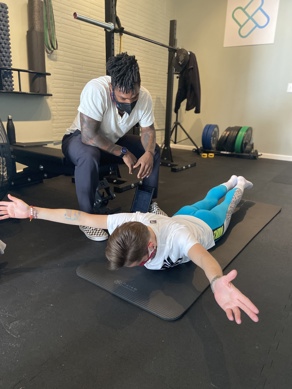Strength and Conditioning; Returning to Dance After a Break - Part 2
Author: Andrew Schaeffer CSCS on behalf of the IADMS Dance Educators Committee
In this series of blog posts we are following Elisa’s training programme as she prepared to return to the stage with Mark Morris Dance Company. In part one we learnt about the content and process of the training programme; here Elisa shares her own thoughts and experiences.

Antoine & Elisa performing posterior core work
What specific concerns did you have around a weight based training program?
Elisa: At this point in my career, I was in a very open space and felt curious to work my body in a new way, especially at my age, and after having taken over a year completely off from dancing. The soreness and tightness in my quads in the initial month didn't feel great to me, however, I was also able to trust the process and know that those feelings would be temporary. Feeling sore or feeling tight from strength training is no different from feeling sore or tight after learning a new piece or rehearsing a one-sided move over and over again. It's a result of repetition and asking your body to do something (or more of something) that you're not accustomed to doing.
Andrew: Elisa’s concerns about feeling sore and tight are common with dancers. The research makes clear that strength training might make you sore, particularly at first, but it does not make you less mobile or less flexible when applied properly in the context of what it is that you are trying to achieve. (Kraemer, Ratamess, & French 2002; Simão et al., 2011 )We make sure to talk openly about that from the start. Moreover, Antoine and I have learned to avoid words like “squeeze”, “tighten”, or even “contract” when working with dancers. Instead we say things like “draw together”, “stabilize”, or “direct energy”—terms that evoke movement and flow.
How did the program impact your performance?
Elisa: The 8+ weeks that I worked with Andrew & Antoine leading up to my performances at BAM was what allowed me to return to stage and to feel confident, strong and free while performing. In conjunction with the strength training, I was also working my way back into shape by taking daily ballet classes. Neither activity alone would have prepared me fully. The strength training provided organization in my body and allowed me to feel strong connections through my legs, core, and upper/lower body, as well as helped me with stamina/endurance.
What are your thoughts about using the Perceived Wellness Survey as part of the program?
Elisa: It is important to pause and notice our mood/emotional/mental state on a regular basis. The physical and mental are so closely linked, so I appreciate Andrew and Antoine's acknowledgement of why it is important to bring this into the conversation.
Andrew: One of the most impactful things we can do for mental wellness is simply to acknowledge that it matters. Validating for someone that what they are feeling is both important and common can have a positive impact all on its own.
What do you think you needed more of?
Elisa: I would like to continue to work on increasing my load amount. So far I've been able to deadlift 115 pounds, and I hope to increase that. I also like the one leg deadlifts, because I find them very helpful to increasing my single leg stability and how that translates into what is needed in choreography. I find them quite challenging, especially on the side of my ankle surgery. Some of the lateral exercises I've been working on with Antoine recently are also very beneficial for my lack of range of motion in that ankle too, so I need to keep going with those. The truth is that many of the exercises that I like the least in the moment (because they are challenging and sometimes frustrating) are the ones I realize I need the most.
Antoine: Elisa realized that this work challenged her in ways that were sometimes frustrating and she would admit that came from feeling like she wasn’t good at it. Elisa has a high level of self-awareness and was able to deal with that frustration. Nevertheless, that is a struggle we often see and it is forefront of our consideration when training performers. It is important to communicate and to set reasonable expectations up front.
Andrew: I want to highlight Elisa’s desire to do more weight. That’s amazing! Many people are surprised at the suggestion that they should squat or deadlift their bodyweight and beyond. It seems like a lot. However, with proper programming and technique, you would be surprised at what you can do.
Andrew Schaeffer, CSCS - Andrew has been a personal trainer and strength and conditioning coach in New York City for over ten years. He has worked with professional athletes, the general population, and is currently focused on professional performers including dancers. He is also earning his Master’s in Mental Health Counseling at Antioch University.
Antoine Simmons, CSCS, MA - Antoine has been a fitness professional for twelve years. He has worked with professional athletes, Navy SEALS, television personalities, and is currently focused on professional dancers. He holds a Master’s degree in Motor Learning and Control from Columbia University.
REFERENCES:
Kraemer, W. J., Ratamess, N. A., & French, D. N. (2002). Resistance training for health and performance. Current Sports Medicine Reports, 1(3), 165–171. https://doi.org/10.1007/s11932-002-0017-7
Simão, R., Lemos, A., Salles, B., Leite, T., Oliveira, É., Rhea, M., & Reis, V. M. (2011). The influence of strength, flexibility, and simultaneous training on flexibility and strength gains. Journal of Strength and Conditioning Research, 25(5), 1333–8. https://doi.org/10.1519/JSC.0b013e3181da85bf